Easter
Special thanks to Elisa and Matthew Leahy for video production and Tom Blosser for music coordination.
The Cross and Resurrection
Prelude | In the bulb there is a flower, for quartet | Myers Family
Peace Candle | Al & Kathy Bauman, JoAnn and Paul Knapke
Opening Words | Jen Cartmel
Call to Worship | Inspired by Luke 1:78-79; John 1:4-5; John 11:25 | Cartmel/Plessinger Family
Leader: Come to me, all you who sit in darkness
and in the shadow of death!
Everyone: On you has the light shone!
Leader: For Jesus Christ is the light of the world
and this is the story;
Everyone: the light shines in the darkness
and the darkness could not put it out!
Leader: Jesus said,
“I am the resurrection and the life.
I am the bright and morning star.”
Everyone: We join with the angels in their hymns of praise;
Glory to God in the highest
and on earth peace, Alleluia!
Leader: Christ is risen!
Everyone: He is risen indeed!
— adapted from Carole Penner, and posted on her Leading in Worship blog.
Easter Greetings from afar | Organized by Phil Hart
- Comunidad Cristiana Menonita de Paz – Our sister church in Armenia, Colombia
- Yasir Makki, Sudan
- David Emch, serving in Thailand
Hymn | HWB 280 Christ the Lord is Risen Today | Tom Blosser
Children’s Time | Elisa Leahy
Hymn | Anita’s Song: Love is a Beautiful Thing | Tom Blosser
Love is a beautiful thing.
Let’s spread it all over.
Love is catching on.
Let’s pass it on, pass it on, pass it on.
Pastoral Prayer | Mark Rupp
God of resurrection and new life, give us eyes to see, ears to hear, and hearts that are open to your presence walking with us along this road of life.
For those of us who still find ourselves re-treading the footsteps of hopes unfilled, asking ‘where did it all go wrong’, we pray that in our breaking open we would find you there.
For those of us who don’t know what to do with strange rumors of good news, we pray that we would know that grace doesn’t require us to have all the answers but to be open to the Spirit being poured out all around us.
And for those of us whose hearts have been warmed by the glow of this Easter morning, may we insist on staying awhile longer, lingering with friend and stranger alike until our fellowship becomes a glimpse of the Risen One.
We lift up to you those in our community who have asked for prayer as well as the prayers on each of our hearts that remain unspoken…
[silence]
On this Easter that might not feel like we think Easter should, help us to know that you walk with us wherever we are on the journey. Guide our feet to follow you in the way of peace. Direct our minds toward understanding and grace. And lead our hearts toward greater love for you and the world around us.
Special Music | Telemann Canonic Sonata | Jeff Myers and Gretchen Myers
Scripture | Luke 24:13-35 | Coble Family
Sermon | The Cross and Resurrection | Joel Miller
When I say “Christ is risen,” you say “Christ is risen, indeed!”
Christ is risen…
Christ is risen…
Sing the Story 98 | On the journey to Emmaus | v. 1 | Alyssa Graber and Austin McCabe Juhnke
On the journey to Emmaus without hearts cold as stone – the One who would save us had left us alone. Then a stranger walks with us and to our surprise, he opens our stories and he opens our eyes.

Sixteenth Street Baptist Church, Birmingham, Alabama. Highsmith, Carol M., 1946-, photographer. Repository: Library of Congress Prints and Photographs Division Washington, D.C. 20540 USA http://hdl.loc.gov/loc.pnp/pp.print. Public domain.
This is the image we had in front of us the first Sunday of Lent. Way back, a whole social era ago, March 1. It’s a stained glass window in the 16th Street Baptist Church in Birmingham, Alabama. That church was bombed in 1963, killing four African American girls and wounding many others. One hand of the black Christ is held open, inviting. The other, held up in resistance. The words from Matthew 25 – “You do it to me,” challenge us, everyone, to consider Jesus in solidarity with all who suffer violence. Along with this particular portrayal of Jesus on the cross we considered the possibility of the cross itself acting like a stained glass window, filtering the light of history, the light of our own experience. Coloring and shading how we see, how we interpret this world.
Throughout Lent, we looked through the cross, like we look through a stained glass window. Looking from different angles, seeing how the light falls. The beautiful shades. The haunting light of the cross.
Like this angle:
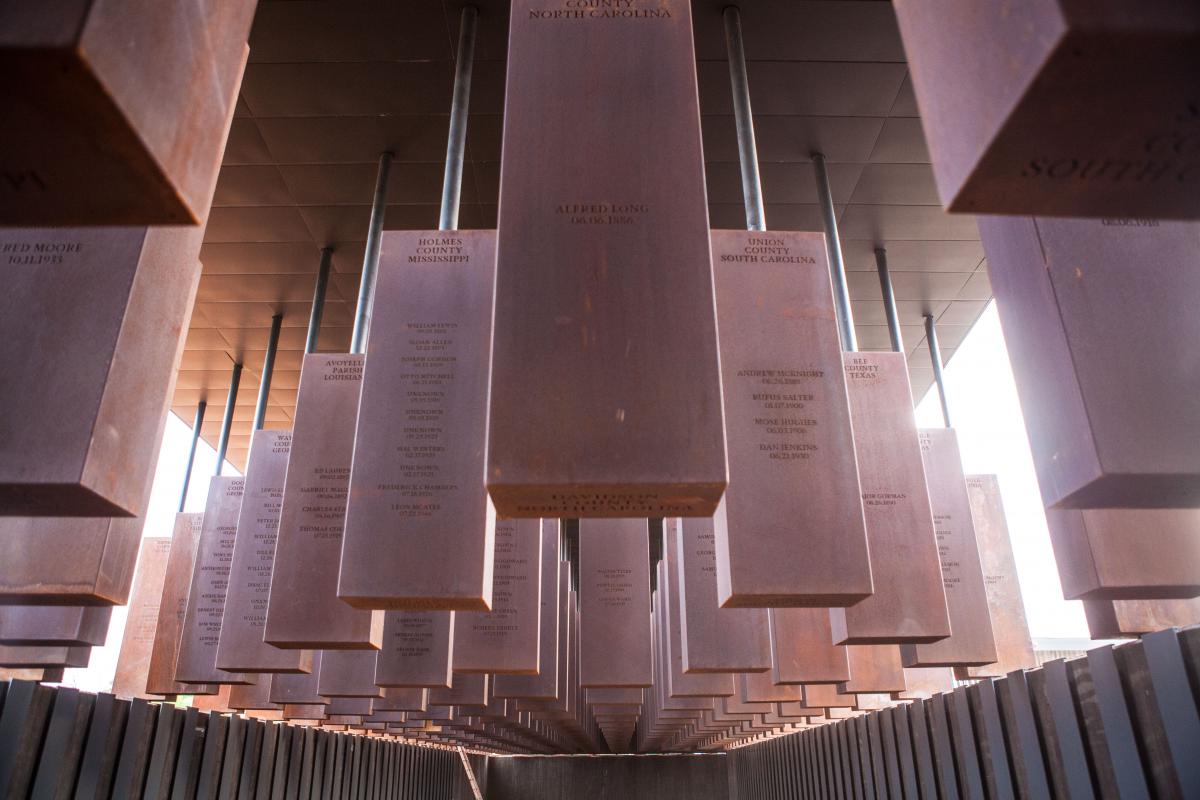
By Soniakapadia – Own work, CC BY-SA 4.0, https://commons.wikimedia.org/w/index.php?curid=68491562
The legacy of racial terror lynchings in the United States, memorialized in these steel monuments at the National Memorial for Peace and Justice . Theologian James Cone writes: “Until we can see the cross and the lynching tree together…there can be no genuine understanding of Christian identity in America.” (The Cross and the Lynching Tree, p. xv)
Or this:
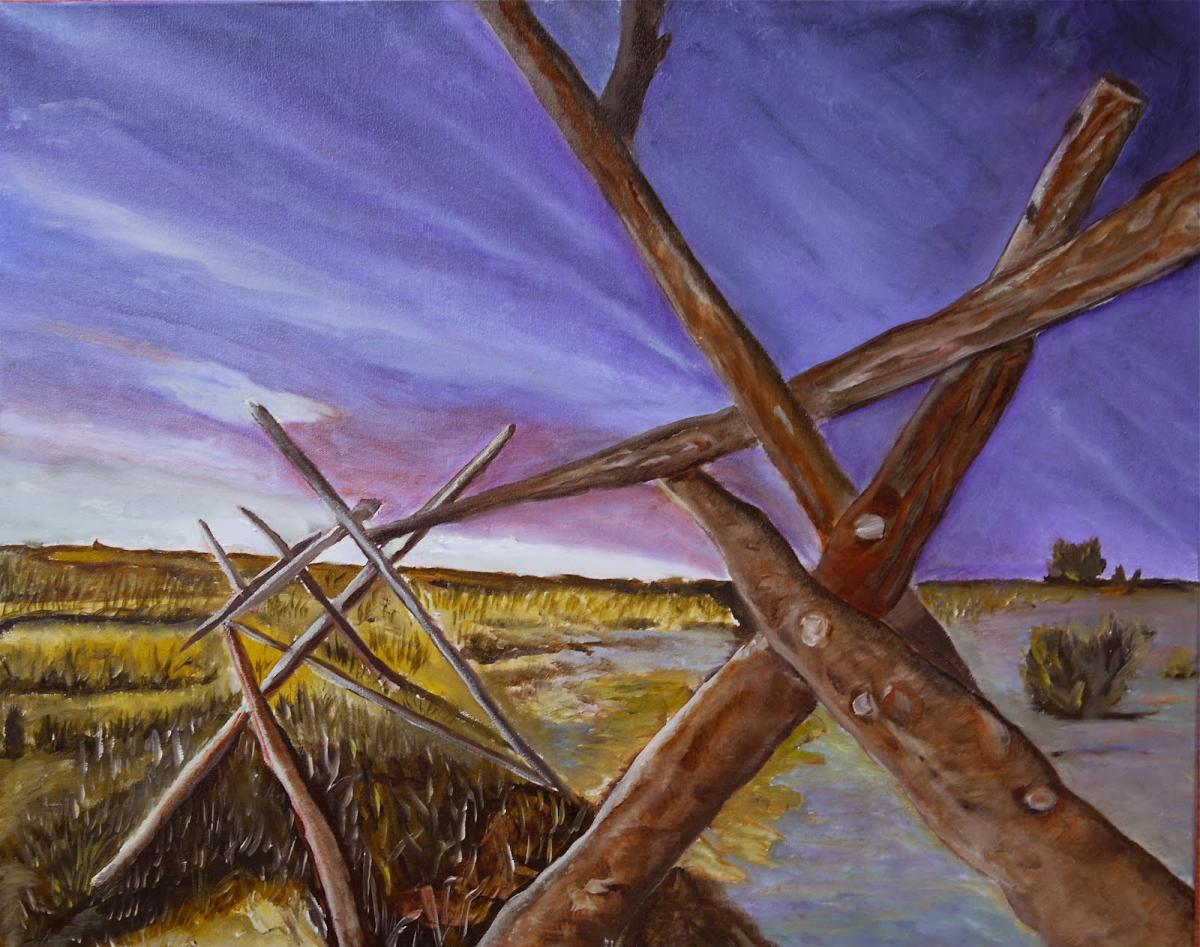
“The Fence: A Tribute to Matthew Shepard” by Mark W. Malone. markm947@swbell.net. http://www.mwmalonefineart.com/ Used by permission.
An artists rendition of the fence on which Matthew Shepherd, a gay college student from Wyoming, was found before he died from the injuries inflicted on him. We considered that there is nothing redemptive about suffering itself. As Mark wrote in his meditation: “When Jesus tells his followers to “deny themselves and take up their cross and follow me” it is not a call to passively suffer but an invitation to accept the system-shaking consequences of living life to the fullest.”
The cross is perhaps most frequently thought of these days as an instrument of atonement – how humanity can be reconciled to God.
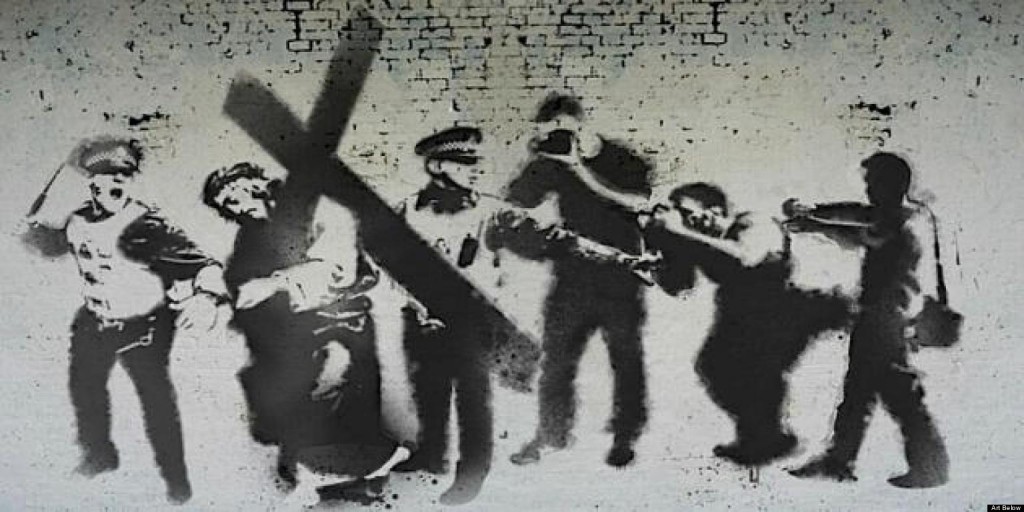
Benjamin Moore, FRSA, artbelow.org.uk. Used by permission.
It’s a conversation that can very quickly set God up as someone in need of a violent sacrifice in order to forgive, rather than the cross highlighting humanity’s need to maintain our fragile unity by scapegoating outsiders and projecting all our violence onto them. We are saved, not from a God who is angry at us, but from ourselves, if we only have the eyes to see. We are saved into a peaceable, reconciling community of all creatures where there is no longer any need for crosses.
A community where even the most violent offenders are recognized as God’s children.
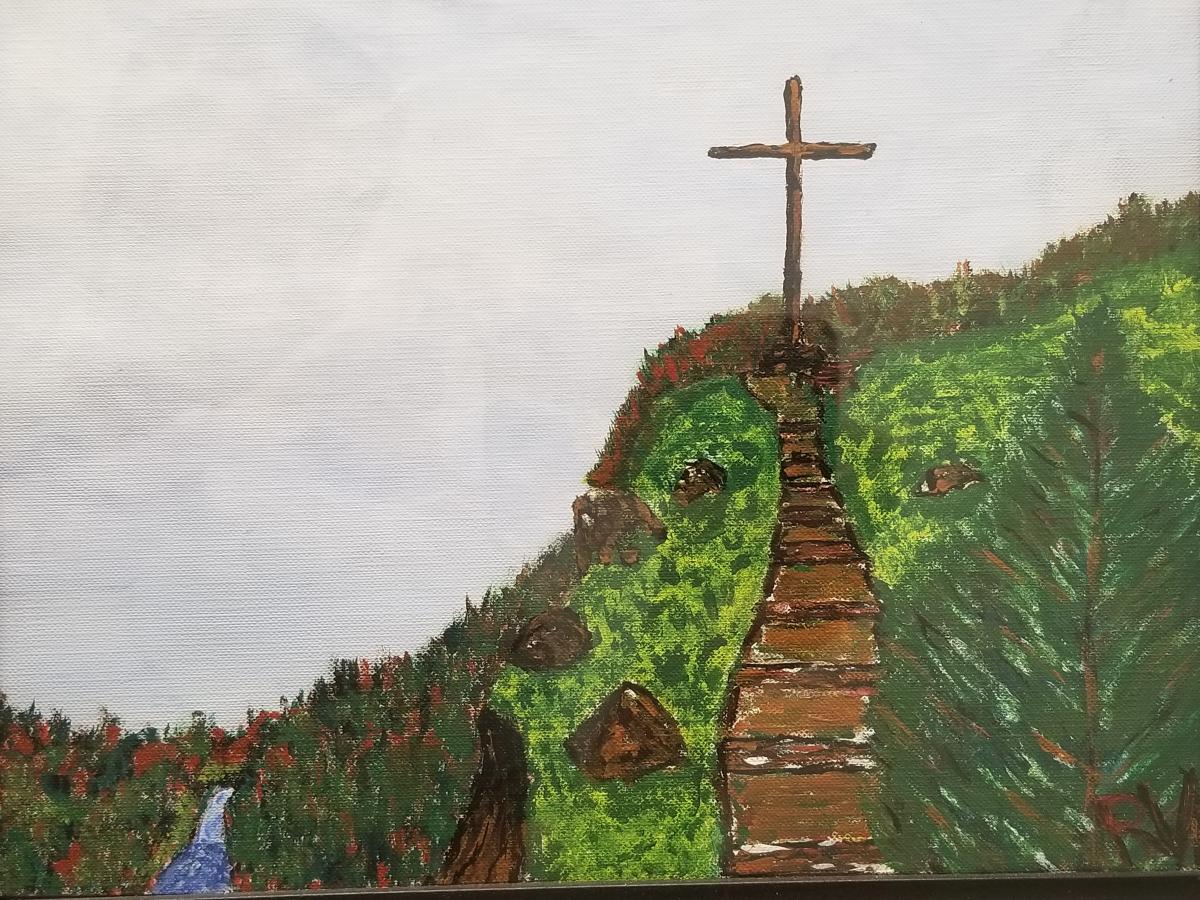
Artist: Robert Van Hook. Used by permission of Allen Bohnert.
This painting of the cross was made by Robert Van Hook, a man befriended by a member of our congregation, Allen Bohnert, and executed by the state of Ohio. Collectively, we still seem to believe that crosses are where some people belong. And that we are better off having put them there.
Perhaps we aren’t personally putting people on crosses, but we are witnesses to it all.
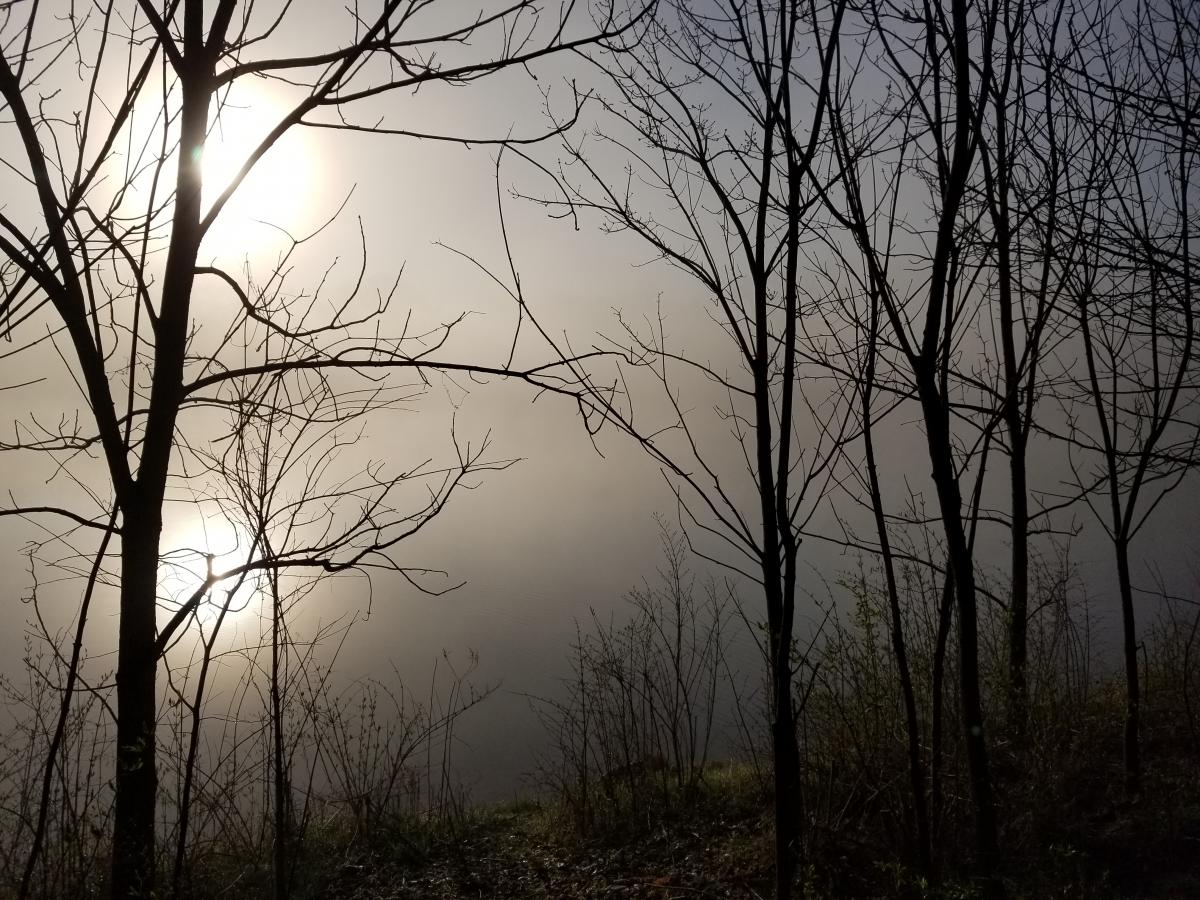
Photo: Joel Miller
We are witnesses to so much. Like the women with Jesus at the cross we are witnesses to horror and our own grief. Like the stones, we are witnesses to ancient patterns and causes for shouting Hosanna and Hallelujah: Beauty, wonder, awe, constancy and change. Every once in while we even get to witness the sun rising out of a foggy lake not far from home.
All this has brought us here. We have journeyed through Lent. And what a Lent-for-the-ages it has been. We have given up church for Lent, in-person-church. And we have given up many other things that used to be a part of normal life. But we have not given up the deeper meaning of being part of the body of Christ. That body which suffered so much, and which, on Easter morning, this very morning we are celebrating, was raised to new life.
Christ is risen. Christ is risen indeed.
And so, consider with me now, this new image.
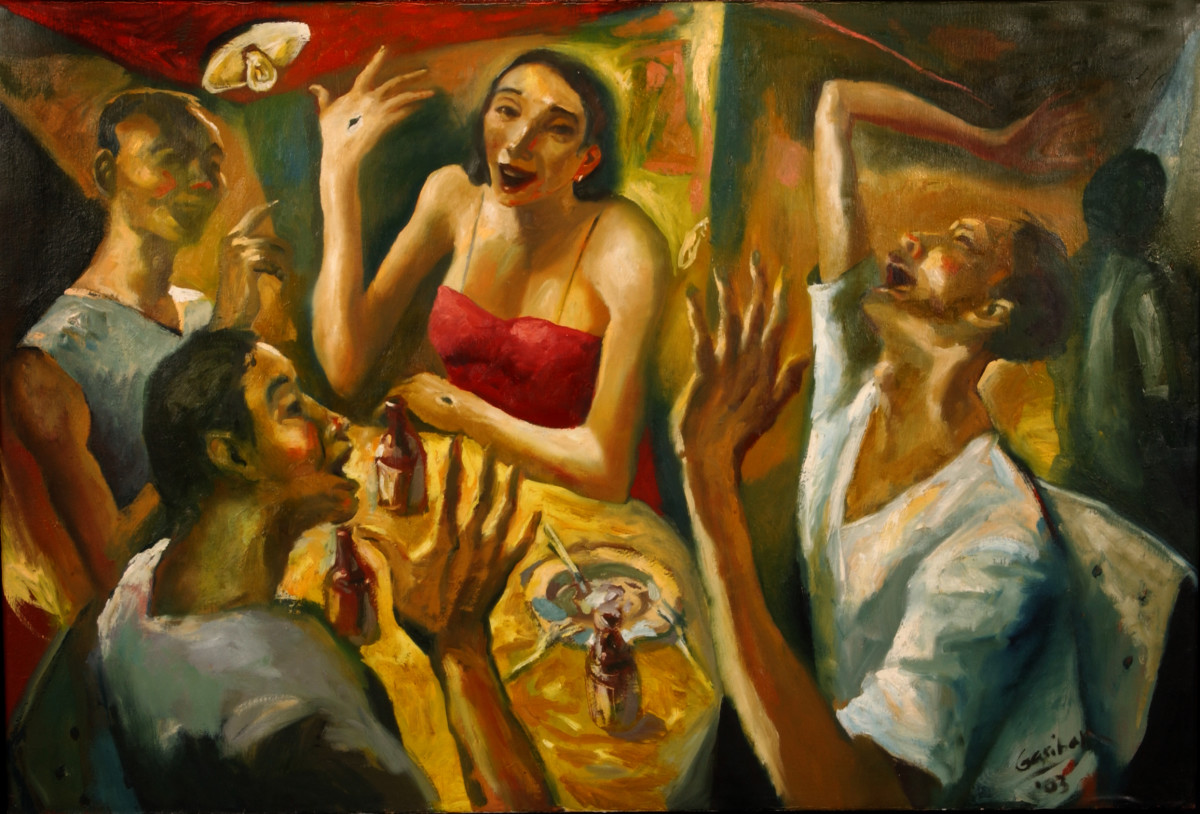
“Emmaus” by Emmanuel Garibay. Used by permission.
The first thing you need to know about this image is that it’s called “Emmaus.” Emmaus, as in the Road to Emmaus, a resurrection story in Luke’s gospel that goes like this: After Jesus was crucified in Jerusalem two of his followers returned from that city to the town of Emmaus. With Jesus gone, the Passover feast ended, there was nothing left for them in Jerusalem. They were, understandably, devastated. Along the way they’re joined by a stranger, someone they do not recognize, who walks with them, talking to them, asking them questions about their sorrow. This hymn in Sing the Story speaks from the perspective of the two travelers:
Sing the Story 98 | On the journey to Emmaus | v. 2 | Alyssa Graber and Austin McCabe Juhnke
And our hearts burned within us as we talked on the way, how all that was promised was our on that day. So we begged him, “Stay with us and grant us your word.” We welcomed the stranger and we welcomed the Lord.
They arrive in Emmaus, and the two insist this unknown traveler lodge with them, an extension of hospitality.
It’s been a long journey, they are emotionally exhausted, the day is ending, and it’s time to eat. They all gather around a table and share an evening meal.
This is the place in the story Filipino artist Emmanuel Garibay chooses to illuminate with his paint brush in “Emmaus.” In his imagination, the discussion around this table is anything but dry theological discourse. An additional friend has joined them, and they have their own corner in what appears to be a café or semi-public area. The plates are clean. The food must have been delicious. And drinks are open. The Christ figure is a woman in a red dress. And something, something is uproariously funny. Christ has gone unrecognized throughout the Emmaus story so far, and we are left wondering if we recognize anything in this scene resembling how we have pictured these events.
In Luke’s telling, the character unrecognized as Christ agrees to stay with these travelers at the end of the day. Luke writes: “When he was at the table with them, he took bread, blessed and broke it, and gave it to them. Then their eyes were opened, and they recognized him; and he vanished from their sight.” For Luke, it is not the physical appearance of the risen Christ that makes him recognizable. It is the act of sharing in table fellowship, communion, the way Jesus did with his companions, that makes Christ present as resurrected among those who share the table with him. The stranger breaks the bread, they recognize him as Christ, and as soon as he is recognized, as Luke says, he “vanished from their sight.”
In this Emmaus painting, Christ has not yet vanished, but it is very likely the artist is asking us to reimagine what it was like the moment before. What was going on in that split second after Christ was recognized, the split second before she vanishes.
It is not a scene of Christ being disappointed or scolding or I-told-you-so or why didn’t you figure this out sooner. It is a scene of pure joy, soul piercing hilarity, being let in on the cosmic humor that Christ had been with them all along and they were so caught up in their own commitments to what was really happening that they missed the effortless grace of resurrection right in their midst. Finally, finally, they get what Jesus got all along. There is a breakthrough. And it is cracking them up so hard they’re almost falling off their chairs.
Sing the Story 98 | On the journey to Emmaus | v. 3 | Alyssa Graber and Austin McCabe Juhnke
And that evening at the table as the blessed and broke bread, we saw it was Jesus aris’n from the dead; though he vanished before us we knew he was near – the life in our dying and the hope in our fear.
One other detail in this painting you’ve likely noticed are the wounds in the hands of Christ. That’s our clue this is Christ, because we’ve heard the stories. We’ve heard other resurrection stories like the one about the appearance to the disciples when Thomas wasn’t around, and how Thomas insisted that he wouldn’t believe it until he himself could personally touch the wounds of the risen Christ. Thomas gets his opportunity, his encounter. His moment of recognition by putting his fingers on the nail marks in Jesus’ hands, in the wounded side.
Resurrection does not erase crucifixion. It is not a linear progression in which the cross is simply one stop on the journey whose ultimate destination is resurrection.
Resurrection contains the cross. It is the next concentric circle out from death. Resurrection contains all the wounds, all the grief, and the heartache of the cross. It’s there in the marks. And in the original Emmaus story, which doesn’t talk about the wounds, it’s there in the absence. Christ is recognized, but is also profoundly absent, vanishing at the point of recognition. The wounds remain. The profound absence remains. But the wounds are contained with the broader circle of healing. The absence is contained within the broader circle of presence.
Every part of the whole story is still there.
Whatever pain and beauty has been witnessed, whatever crosses remain in operation, whatever atonement has been made, whatever suffering has been experienced and been afflicted, whatever light has seeped through and illuminated the spaces we inhabit.
Whatever pain and grief we hold in our bodies does not simply go away. But it is invited around the table with Christ, who shows up in the most surprising of ways. Breaks the bread and lets us in on the most hilarious, the most delightful, the most stunning thing of all:
Resurrection has the final word, and we have no idea, no idea, what it will look like.
Sing the Story 98 | On the journey to Emmaus | v. 4 | Alyssa Graber and Austin McCabe Juhnke
On our journey to Emmaus in our stories and feast, with Jesus we claim that the greatest is least: and his words burn within us – let none be ignored – who welcomes the stranger shall welcome the Lord.
Closing Song | And the Glory of the Lord | From CMC December 2019 recording
Benediction and Communion Invitation | Mark Rupp
Friends, if you are planning to join us at 11am for the live communion service via Zoom, I will offer a few words of instruction after the benediction. If you are unable to join us at that time, you can also also watch the recorded version when that becomes available.
Either way, I offer all of us this benediction:
May the same Spirit that brings new life where once there was only death, continue to move you every day toward new possibilities for freedom.
May the Risen Christ be your companion around whatever tables you gather, opening your eyes to the paths of eternal living.
And may the God who continues to say “no” to the tyranny of death, injustice, and evil in whatever form they take, may you find this God meeting you right where you are on the path but refusing to leave until you’ve found your way home.
Amen.
And happy Easter everyone.
For those that will be joining for communion, a couple instructions first.
We will aim to begin around 11am, but you can feel free to join the meeting earlier, especially if you are new to Zoom and might need a few minutes to get situated. To join the meeting, all you should need to do is click the link that will be sent. Once you are connected, you may need to click the button marked “Join Audio” in order to hear the leaders.
It will be great to be able to see one another, but the limitations of Zoom are such that large groups of people can become chaotic pretty quickly if more than one person tries to talk at once. Because this is Easter and not Pentecost, we will be muting everyone except those who are helping lead. As we figure this out, you can help by muting yourself once you’ve joined.
During the service, the text of the liturgy should appear on the screen for you to read along on the parts in bold. You are invited to speak along with the bolded parts of the liturgy but you will only be able to hear Joel and his family leading those parts.
Whether you plan to join live or participate at a different time with the recording, you will want to make sure you gather your supplies beforehand: this includes enough bread and juice for everyone who will be participating with you, or any substitutes that are available to you are fine. Full disclosure, we never have juice at our house, so I will probably be using some hibiscus tea.
Which leads me to a final point before we begin. Here at Columbus Mennonite, we practice an open communion table, which means that anyone who hungers and thirsts for God is welcome to join. You have likely heard us share these words before, but these unprecedented times call for a bit of a deeper exploration of communion. While those words still hold true, some of you may not feel comfortable blessing and serving your own communion and some of you may still be discerning what it means for children to participate. We come from many different theological traditions and for some, this is completely new territory.
While you should certainly do whatever will help you connect most fully with God and with one another, I will say that in our Mennonite tradition, practices like communion are less about getting rituals and words just right and more about celebrating the Spirit of God that is unfolding in our lives. As a priesthood of all believers, you don’t need Joel or I to be there to know that God is moving among you. Whether you have the fanciest loaf of homemade bread or a slice of Wonder bread, whether the finest juice or tea that kind of looks like the right color, you can trust that God is there among you.
So come, let us prepare ourselves to celebrate the God who is revealed equally around altar tables in grand sanctuaries and humble kitchen tables everywhere.
Easter Communion (recorded from live Zoom chat on Easter morning)
